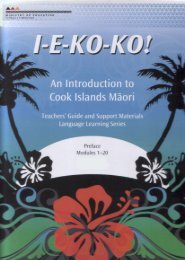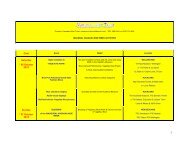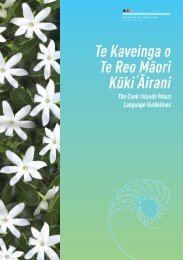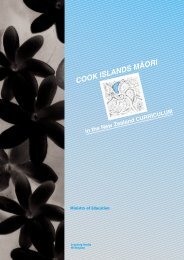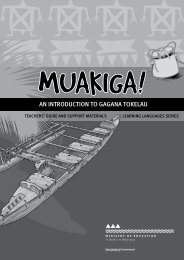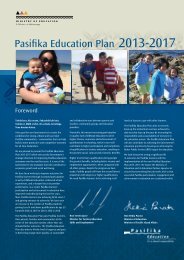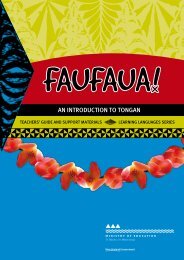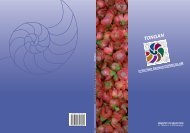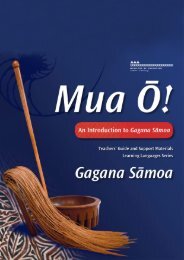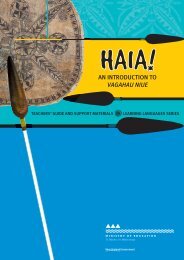Ta'iala mo le Gagana SÄmoa - Pasifika Education Community
Ta'iala mo le Gagana SÄmoa - Pasifika Education Community
Ta'iala mo le Gagana SÄmoa - Pasifika Education Community
Create successful ePaper yourself
Turn your PDF publications into a flip-book with our unique Google optimized e-Paper software.
Atamai i <strong>le</strong> Aganu‘uCultural Know<strong>le</strong>dgeStudents will:‘O ni fa‘ata‘ita‘iga i <strong>le</strong> aganu‘u fa‘asā<strong>mo</strong>aSuggested aspects of fa‘asā<strong>mo</strong>aStudents could be <strong>le</strong>arning through experiences that allowthem to:90• recognise and express fa‘aaloalo andtautua in a variety of contexts;• explore how the use of gagana Sā<strong>mo</strong>aconveys cultural meanings.• express fa‘aaloalo in various contexts by using the followingkinds of language appropriately:Fa‘aaloalo e ala i <strong>le</strong> tautua – ‘O <strong>le</strong> ala i <strong>le</strong> pu<strong>le</strong> o <strong>le</strong> tautuaFa‘atino ma mālamalama i tautua ‘ese‘ese (understanding andpractising different ways of serving):Tautua tuāvae – ‘o <strong>le</strong> fai o fe‘au i totonu o <strong>le</strong> ‘āigaTautua matavela – o <strong>le</strong> fa‘atino o <strong>le</strong> gāseseina ma <strong>le</strong> kukainao mea‘aiTautua ‘upu – ‘o <strong>le</strong> fai o tautalaga po ‘o lāuga <strong>mo</strong> <strong>le</strong> ‘āiga (forexamp<strong>le</strong>, as a matai who is an orator – tulāfa<strong>le</strong>)Tautua mamao – ‘o <strong>le</strong> lafo o tupe, mea‘ai, lāvalava i ‘āiga iSā<strong>mo</strong>aTautua toto – ‘o <strong>le</strong> oti, po ‘o <strong>le</strong> masa‘a ‘o <strong>le</strong> toto <strong>mo</strong> lou ‘āiga/atunu‘u (for examp<strong>le</strong>, as a soldier – fitafita)Tautua e lē <strong>le</strong><strong>le</strong>i (serving in the wrong way):Tautua pa‘ō – e fa‘ali‘i ma pa‘ō <strong>le</strong> fa‘atinoga o fe‘auTautua gutuā – ‘o <strong>le</strong> tomumu ma fai fe‘auTautua fia matai – e ala ona fai <strong>le</strong> tautua ‘ona ‘o <strong>le</strong> fia matai.• discuss tit<strong>le</strong>s, for examp<strong>le</strong>, explore the concept of a mataiand interview a family or community member using languagesuch as:‘O ā igoa matai ‘o lou ‘āiga? Tamā/tinā.E matai lou tamā?‘O se ali‘i po‘o se tulāfa<strong>le</strong>?‘O fea <strong>le</strong> nu‘u e matai ai?;• identify matai tit<strong>le</strong>s that are linked to specific villages;• explore literal and figurative meanings of sayings, for examp<strong>le</strong>:Mālō <strong>le</strong> soifua maua ma <strong>le</strong> lagi e mamā (formal greeting inspecific contexts)‘Ua tātou feiloa‘i i luma ‘o <strong>le</strong> nu‘u ‘ae lē o tua o <strong>le</strong> nu‘u (part ofa speech that conveys the idea of meeting on good terms withgood intentions)‘Ua ta fia Fa<strong>le</strong>ālili fua (an expression of pride and happinessfor what someone has achieved).



